

12/2005

by Meredith Banasiak,
Assoc. AIA
Research Associate, Academy of Neuroscience for Architecture
When George Mason University’s Krasnow Institute for Advanced Study, in Fairfax, Va., needed to add 12,500 square feet of laboratory to its existing 25,000-square-foot higher education facility, the request for proposals generated by the university’s planning department—in accordance with university standards—contained typically prescriptive information about the proposed addition. Given the competitive nature of the university-chosen design-build delivery method, the three competing architect/contractor teams did not have much opportunity to research the Krasnow Institute’s existing culture and its use of space. Thus, the Academy of Neuroscience for Architecture undertook an independent programming study to increase user input to inform the teams’ respective designs and bid packages.
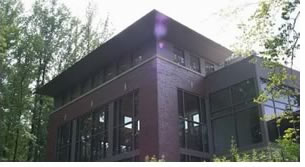 An anonymous director of a recently acquired neuroscience laboratory
told us that many of the scientists hated the new building’s spatial
openness, while others found the arrangement stimulating. However, they
universally expressed unhappiness that none of them had been consulted
in advance about the design decisions agreed upon by upper management
and the architects. To rectify this potential situation for the Krasnow
Institute, we decided to use “the blog,” a means of information-sharing
that can bridge the gap among parties typically not communicating with
one another.
An anonymous director of a recently acquired neuroscience laboratory
told us that many of the scientists hated the new building’s spatial
openness, while others found the arrangement stimulating. However, they
universally expressed unhappiness that none of them had been consulted
in advance about the design decisions agreed upon by upper management
and the architects. To rectify this potential situation for the Krasnow
Institute, we decided to use “the blog,” a means of information-sharing
that can bridge the gap among parties typically not communicating with
one another.
During the addition’s programming phase, the blog proved an effective tool with which to solicit participation of faculty and staff, a group of people often regarded as too large to assemble, whereas consulting individually would be too time consuming. In addition, the blog established a passive communication among groups of people typically isolated from one another, as in the case of the three competing design teams and the Krasnow Institute end-users.
Programming measures
The initial impetus for the blog was to have a “honey pot” to
lure data-seeking competing teams and feed them relevant programming
data that ideally would materialize in the designs. We obtained the information
from individual interviews with the Krasnow faculty and staff. It was
distilled into the following user-derived design principles that began
to outline performance criteria for the building:
- Growth will result in change
- Labs must be flexible
- We like our trees
- Krasnow is interdisciplinary
- Krasnow is unique
- Amenities promote perseverance.
The Krasnow Institute management realized that it was critical to involve their faculty and staff, the building’s end-users, in the programming phase. Because of the interdisciplinary—yet collaborative and communal—nature of the institute, each person’s input was necessary to develop a cohesive understanding about the way that a diverse group of people and their work come together.
 Conventional
program development often is limited to a two-way conversation between
a building representative and the architect. In many instances, the representative
does not necessarily have firsthand knowledge of the needs and issues
associated with how the end-users inhabit their space. By involving the
end-users in the information gathering process, the expectation is that
the resulting designs will be more informed, and performance-based from
the beginning.
Conventional
program development often is limited to a two-way conversation between
a building representative and the architect. In many instances, the representative
does not necessarily have firsthand knowledge of the needs and issues
associated with how the end-users inhabit their space. By involving the
end-users in the information gathering process, the expectation is that
the resulting designs will be more informed, and performance-based from
the beginning.
What has come to be known as “The Giorgio Principle” by those involved with this study—so named on account of the faculty member who contributed the information—testifies to the importance of involving end-users and the value of the information gleaned. The Giorgio Principle states that: “the trees (woodlands) are a source of inspiration in my study because the branching helps me visualize neurons. The window acts as a microscope in the office providing a view of enlarged neurons.” Armed with this specific insight, the location, size, and orientation of windows and the conservation of trees can become integrated design elements in planning the offices and labs.
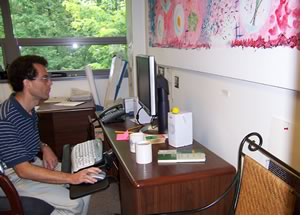 Perceived benefits from the blog tool
Perceived benefits from the blog tool
In our study, blog technology has proven an effective tool to establish
feedback loops, distribute information collected from the interviews,
and yield quantifiable statistics about who is accessing the data.
The blog also proved an effective tool to encourage and manage end-user involvement. Involving a greater number of people in the programming phase required a greater degree of managing the acquisition and synthesis of the information—for which the blog tool was well suited. Establishing a virtual interface created self-sustaining feedback loops; therefore, a greater audience could be targeted with less effort. A dialogue was established where end-users could voluntarily view and respond to assumptions posted on the blog by the programming administrator and to ideas posted by their colleagues. For example, in response to the post on the Giorgio Principle, two end-users wrote in to share and document their experience with the trees:
“Trees are much more inspirational than a brick wall. Everyone who has visited me has commented on the trees. We should do what we can to protect them as we expand.”—Ernie
“I agree, Ernie . . . I view the whole of the woodlands as something very special (and to be preserved). Even the trees in the winter can be spectacular against the snow.”—Anonymous.
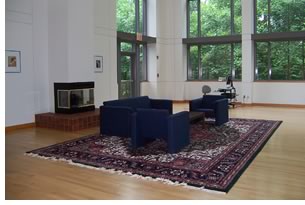 With this momentum in place, another end-user went so far as to seek
out the local city arborist to recommend inexpensive strategies for preserving
the trees during construction. In this way, a design-related assumption
could be validated, clarified, challenged, or debated. The democratic
venue provided by the blog allowed everyone to contribute his or her
experiences.
With this momentum in place, another end-user went so far as to seek
out the local city arborist to recommend inexpensive strategies for preserving
the trees during construction. In this way, a design-related assumption
could be validated, clarified, challenged, or debated. The democratic
venue provided by the blog allowed everyone to contribute his or her
experiences.
The blog boosted interview participation because it acted as a collective space that could be conveniently accessed according to an individual’s particular schedule and location, and each person had the option to post anonymously. Given the intense demands and exhaustive schedule of the scientists—the Krasnow Institute’s end-users—it was unrealistic to expect that there would be a significant time and participation commitment to the blog on their part. As such, it was important to establish an enticement to keep the readers coming back. This was achieved by Krasnow director Dr. Jim Olds inserting gems of information—not necessarily related to the construction project—on an infrequent, random basis so that the end-users would develop a selfish interest in accessing the blog in hopes of discovering important announcements. Dr. Olds also solicited participation by example, posting his own comments and responses to the blog posts.
The broadcast communication benefit provided by the blog tool kept the end-users informed about the anticipated construction and alleviated stress associated with “the unknown.” Even if the participation from the end-users was strictly passive, such that they read but did not respond to the content on the blog, the broadcast communication benefit provided by the blog tool effectively kept the end-users informed about the anticipated construction. Dr. Olds had the foresight to have anticipated the stress and unknowns associated with the architectural and subsequent cultural change. He addressed it in an innovative and interpersonal manner by implementing the blog tool. Keeping people in the loop resulted in fewer unknowns and less anxiety about what was to come and established realistic and known expectations.
The blog can become an electronic database so that the design intent established at the beginning of the project does not get lost throughout the process. In the design and construction phases to follow, the blog can become an electronic database available to all trades at any phase of design or construction. Thus, the design intent or performance criteria established at the beginning of the project does not get lost during the project-development process. Contractors, subconsultants, and interior designers all could have access to the programming information. An added benefit is that blog technology is a low-cost (essentially free) tool for the trade.
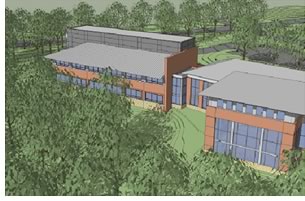 The blog provided user statistics that could
be tracked and recorded. A Web-tracking service allowed us to determine how many people visited
the site and, more importantly, who was visiting the site. These tracking
statistics yielded quantifiable data that indicated how successfully
the blog was performing at any point during the study. The Web tracker
also provided a good indication of which firms and contractors visited
the blog, how often they returned, and which posts they accessed.
The blog provided user statistics that could
be tracked and recorded. A Web-tracking service allowed us to determine how many people visited
the site and, more importantly, who was visiting the site. These tracking
statistics yielded quantifiable data that indicated how successfully
the blog was performing at any point during the study. The Web tracker
also provided a good indication of which firms and contractors visited
the blog, how often they returned, and which posts they accessed.
Using the Web-tracker statistics, we determined that Kishimoto Gordon Dalaya PC Architecture (KGD) had a consistent and significantly greater presence on the blog than the other two teams throughout the study. During this particular team’s proposal presentation to the selection committee, the architect reiterated the user-derived design principles as posted on the blog and stated specific examples of where their design responded to these principles. For example, KGD incorporated interstitial spaces enhanced by daylight and views within the circulation spaces to promote interactive pauses and opportunities for collaboration (Principle 4). The team’s architect, T. Ben Kishimoto, commented during the presentation that he found the blog “a very valuable and informative tool in giving insight into what is important to users.”
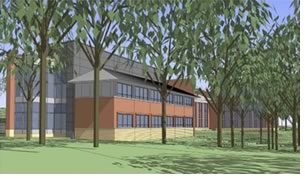 This team did receive a high technical score for their programmatically
responsive design. Although it is understood that there are other factors
(such as budget and experience) that justifiably weigh into the design-team
selection, with respect to this study, the blog proved successful in
demonstrating a practical implementation of the data it contained and
in closing the feedback loop by responding to the end-users’ priorities
and concerns.
This team did receive a high technical score for their programmatically
responsive design. Although it is understood that there are other factors
(such as budget and experience) that justifiably weigh into the design-team
selection, with respect to this study, the blog proved successful in
demonstrating a practical implementation of the data it contained and
in closing the feedback loop by responding to the end-users’ priorities
and concerns.
Convenient, inexpensive, and informative
What began as a convenient and inexpensive method for programming proved
to have larger applications for information-sharing using feedback
loops and distributing information. We used the blog to encourage and
manage end-user involvement, and as such alleviated stress by keeping
end-users informed about the anticipated construction. At least one
of the competing design teams found that access to the programming
data was able to inform their design. As a means of facilitating communication
among the many parties involved with design and construction, the blog
has promoted performance-based design. Not only did the blog prove
to be an effective tool in programming, if updated, it could continue
to aid the construction process through a post-occupancy evaluation.
Copyright 2005 The American Institute of Architects.
All rights reserved. Home Page ![]()
![]()
John Eberhard, FAIA, ANFA managing director, Washington D.C. office, and Jim Olds, PhD, director, Krasnow Institute for Advanced Study, contributed to this article.
Building Perspective, Kishimoto.Gordon.Dalaya PC Architecture
Aerial Perspective, Kishimoto.Gordon.Dalaya PC Architecture
![]()